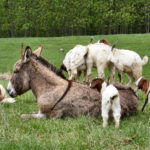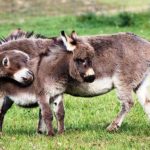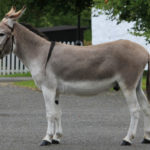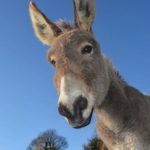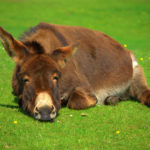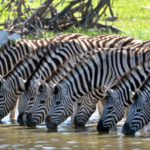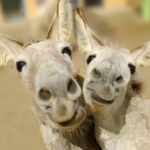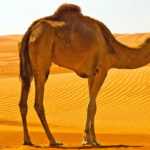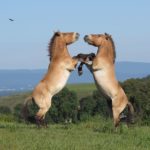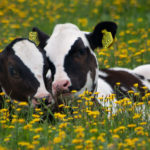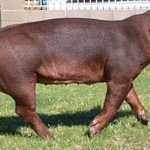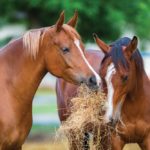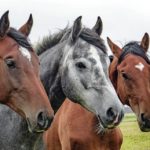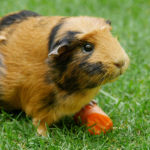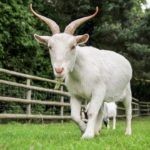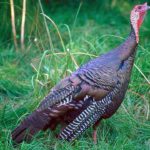Donkeys
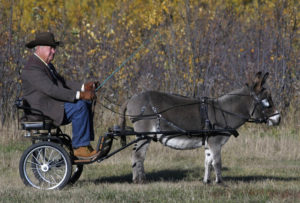 Domestic donkeys have become known as ugly, unpretentious and very stubborn animals, that is, they deserve people’s rather negative evaluation than good glory. But, as it turns out, much of what we know about these animals is wrong. Domestication of donkeys occurred about 4000 years ago, that is simultaneously or even slightly earlier than the domestication of a horse. The center of domestication was Ancient Egypt and the surrounding areas of North Africa and the Arabian Peninsula. Domestic donkeys originate from a wild African donkey, although some researchers believe that later Asian wild asses – kulans – could participate in the formation of Asian breeds.
Domestic donkeys have become known as ugly, unpretentious and very stubborn animals, that is, they deserve people’s rather negative evaluation than good glory. But, as it turns out, much of what we know about these animals is wrong. Domestication of donkeys occurred about 4000 years ago, that is simultaneously or even slightly earlier than the domestication of a horse. The center of domestication was Ancient Egypt and the surrounding areas of North Africa and the Arabian Peninsula. Domestic donkeys originate from a wild African donkey, although some researchers believe that later Asian wild asses – kulans – could participate in the formation of Asian breeds.
In the areas of domestication of donkeys there were no horses (they were domesticated to the east – in Central Asia), therefore at home for the first time they were the only vehicle. The first domestic donkeys were used as pack animals, harness and productive animals and their scope was very wide: donkeys were used not only for agricultural work, for obtaining meat, milk, but also as … combat. It is known that the ancient Sumerian war chariots were dragged precisely by the quads of donkeys.
In general, initially these animals were very popular among people, their content was very profitable and gave the donkey owner considerable advantages over fellow citizens, so they quickly spread to all countries of the Near and Middle East, and later came to the Caucasus and southern Europe. In all areas with a hot and dry climate, the donkeys were used no less, and sometimes even more profitable, than horses, and therefore in a later time these animals colonized the newly discovered land. Thus, a large number of donkeys are available in all countries of Africa, India, China, the USA, Mexico, and many countries of South America. Now the world livestock of these animals totals 45 million and this despite the fact that in the developed countries they were replaced by mechanized transport. The best breeding stock of donkeys is concentrated in Spain, France and the USA. The Democratic Party of the USA has chosen the donkey as its symbol, as an embodiment of diligence, the donkey is also a symbol of the Spanish province of Catalonia. At the same time, in some countries donkeys are considered “second-rate” pets, a sign of poverty and simplicity. So what is the reason for such a different attitude to these animals of different people?
Many valuable economic qualities of domestic donkeys are inherited from wild ancestors living in the desert. First of all, it is unpretentiousness and ability to eat any kind of fodder. In fact, donkeys eat almost all herbaceous plants, including prickly plants, can scrape branches of shrubs, there are materials containing plant fibers (cloth, paper, ropes), and especially like thistle. In connection with such omnivorous donkeys in most cases do not need additional feeding, they only need pastures, which can be any waste land or even a dump. In some cases, giving additional food to donkeys is even harmful, as they quickly become fat. That’s why the donkeys turned out to be irreplaceable animals in areas with a shortage of good pastures and water.
In addition, donkeys are doubly profitable, since they do not require any other maintenance costs. They are well tolerated by the heat and slight colds, so in warm areas they are quite enough for a small canopy or a covered enclosure (only 4.5-6 m² per animal). Hooves of donkeys have a very strong horn, so these animals do not need forging. And according to other physical indicators, donkeys are very healthy and durable animals. But their main advantage is extraordinary endurance. Donkeys are able to work without interruption for 8-10 hours a day, they have a huge load capacity. If a horse can carry a load on its back, the weight of which does not exceed 30-50% of its own weight, then the donkey can carry 50-70%, and in exceptional cases even 110% of its own weight!
